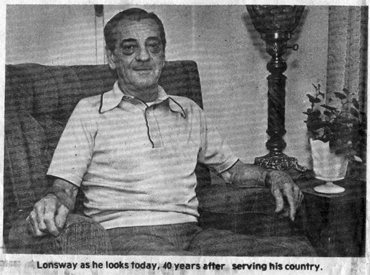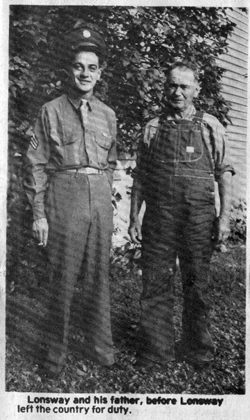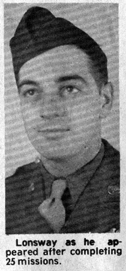June 30, 1983



Picture #1 (missing) – “Skippy” the B-17 Flying Fortress, on which Fostorian Clarence Lonsway and nine others waged war against Hitler in World War II. The planes above are P-47 escort fighters.
Picture #2 – Lonsway as he looks today, 40 years after serving his country
Picture #3 – Lonsway and his father, before Lonsway left the country for duty.
Picture #4 – Lonsway as he appeared after completing 25 missions.
Ask Clarence Lonsway, 315 Elm St., about his participation in World War II. Ask him about his part as a gunner on a Boeing B-17 Fortress, how those giant planes made it possible to destroy important supply centers in enemy territory and shorten the duration of the war.
From memory and a box full of clippings and photos he has kept for 40 years, he could tell many tales and probably write a book about his experiences on “Skippy” the name given to the Fortress by the crew of 10.
Before Lonsway would finish his story telling, he would probably remark about how long it took the U.S. to get organized to actively participate in World War II and what he believed would happen to the U.S. today in similar circumstances.
Lonsway loaned me the box of information and threw in some interesting conversation. So I’ll try to turn it into today’s article.
I must say that Lonsway is not a boastful man and, in the process of the interview, he placed no praise on his own war record. In fact, he emphasized that he was more concerned about the article, emphasizing the need for adequate defense of our country and what would happen to us in today’s world with nuclear warfare.
“One and a half years after Pearl Harbor, this country was still not adequately prepared to wage a global war”, Lonsway said. “Today, with nuclear weapons in the hands of our enemies, we wouldn’t have a year and a half. Soviets missiles would find their mark in the U.S. and elsewhere within minutes of launching”.
Lonsway also said, “We should have learned from the Soviet leaders when the peace treaty was formulated after World War II that they could not be trusted”.
He believes that President Reagan’s defense policies are the only answer for the safety of the U.S.; that those policies are going to cost each of us something in dollard and sacrifice, just as winning World War II did; but today, war is a different conflict than then; we must preserve the peace through strength, not appeasement, or else become an enslaved nation.
Lonsway entered the service in July 1942. He trained at the Aerial Gunners School at Las Vegas, Aerial Mechanics School at Gulfport, MISS. and Boeing aircraft factory training at Longbeach, Ca.
He became a staff sergeant and served as a member of the 390th Bombardment Group H from July 1943 to November 1943 in the European Theater of Operations. During that period, he served in the capacity of right waist gunner, flying a total of 22 sorties, in the course of which were missions to enemy occupied Norway, France, Holland and such German cities as Bremen, Marienburg, Durein, Schweinfurt and Emden.
Lonsway was awarded the Air Medal, Three Oak Leaf Clusters and the Distinguished Flying Cross. He was also officially credited with destroying one enemy aircraft.
The big B-29 Super Fortresses, designed and built by Boeing, were engineered to perform at altitudes of 7 1/2 miles. They had very effective firepower and could absorb punishment and still keep flying. But, according to Lonsway the B-17’s in combat were generally flown at altitudes of approximately five miles.
“Every maneuver known to combat flying was used by German airmen in their endeavor to stop the forts. They tried coming in from every point of the compass, above and below. The Germans devised new tactics, new weapons, rocket guns, mass attacks, but they did not success in turning back the Fortress crews from their targets.
The development of daylight precision bombing is one of America’s great sagas. It is an epic of rave and skillful men gunners, radiomen, navigators, bombardiers and pilots, backed up by astute planning and effective ground crews…so read an advertisement by Boeing during World War II.
One of the many newspaper clippings stowed away by Lonsway pertained to the raid on Germany’s huge Schweinfurt factory where ball and roller bearing were produced.
Both sides knew it would be a major engagement, this being the second mission on that factory on Oct. 14, 1943. The first mission, three months earlier, was never completed.
The Nazis had massed 60 percent of their total fighter strength in a vain effort to prevent the flying forts from getting through on the October mission. but, in a period of a few hours, the forts invaded German-held Europe to a depth of 500 miles, sacked and crippled one of her most vital industries. They did it in daylight. The moved in on the city of 50,000 people and destroyed that part of it that contributed to the enemy’s ability to wage war. When that part of it was a heap of twisted girders and pulverized machinery, they handed it back, completely useless to the Germans.
The Germans tried the same tactic in the Battle of Britain and gave it up as too costly when 185 of their own planes were shot down in a single day.
The second mission to annihilate the ball bearing industry at Schweinfurt was Lonsway 17th. It was on that successful mission that the U.S. lost 60 forts and 600 men (10 men on each). It was estimated that perhaps 50 percent of the men parachuted to safety.
If each of those forts cost $4 million (guesstimated), that was a total of $240 million lost in a matter of perhaps 10 minutes of bombing time, not to mention loss of lives and other costs for the one raid alone.
Worth it? What is freedom worth?
Those who settled this land and fought to preserve their freedom thought the price they paid was worth it. Those who fought to preserve the Union thought it was worth the price.
Lonsway wrote short notes about his various missions, all of which were preserved and brought home. Here’s one about the Schweinfurt raid:
“Went into Germany yesterday to get a ball bearing factory. We really blasted it. Ball bearings must be rolling yet. Not much trouble going in, but plenty of fighters on the way out. Flak was accurate over the target and it rocked the ship several times. Got by with about eight holes. Seen lots of parachute jumps from B-17’s. Plenty rough. Expect all of them to be rough from now on because we will always be going into Germany. My remaining eight missions will be the same if I make the 25”.
In regard to those who had to parachute from their disabled planed, whether U.S. flyers or German, Lonsway had this to day:
“No effort was made to shoot parachuting pilots on either side. Both sides interrogated captured pilots to learn what they could”. He also said, “Often when a plane was badly disabled and trying to get back home, a German pilot flew close to look see and then waves as much as to say Good Luck”.
Here’s what Lonsway had to say in a note after the 15th and 16th mission, both to Breman, Germany:
“Two of the toughest I’ve been on yet and in fact the most wicked air battles ever encountered in this war. Our first trip was one for the books. It looked bad for us when one engine went out before we reached the target, but we hobbled in, dropped our bombs in the center of it and made our way back to Britain”.
On his next trip, Lonsway destroyed a Nazi fighter.
“I was handling the tail guns when shortly inside Europe, I discovered there were plenty of enemy fighters for every gun position. three came in on the tail and I picked the one in the middle and let him have it. Suddenly, he shot straight up. Another burst and his right wing went off and he went down burning. The other two peeled off and left. It was 40 degrees below zero, but I wiped the sweat from by forehead”.
Many of Lonsway’s notes expressed his opinion that his chances looked slim of finishing his 25 missions.
“Air War against Hitler’s Germany” is an American Heritage junior library book in all of the Fostoria public school libraries. It contains information and photos about the subject of today’s article.
When Mr. Lonsway’s grandson, Donavon, was in the sixth grade, discovered that the book contained some of the same photos he had seen in his grandfather’s box of memorabilia. So, he shared the book with his grandfather, who quickly discovered that some of the information was not complementary to this country’s war effort. The authors did, however, explicitly point out the unpreparedness of both the U.S. and Great Britain to defend themselves initially.
Again, the lessons of World War II should warn Americans of the need for strong defense and shame those who would advocate appeasement.
Lonsway was a New Riegel farm boy, son of Mr. and Mrs. Amadeus Lonsway. When he had completed his 25 missions, he had fulfilled his duty to his country and could have returned immediately to take up life where he had left it. However, after returning to the U.S., he served as an instructor for a period of time for new recruits in training at Ardmore Army Air Base in Ardmore, OK.
Later, he returned to farm life with his folks. Still later, he worked at Seneca Wire, Nye, Inc., Central Transport and for his brother Ernie, in the automotive repair business.
Some readers may recall seeing a squadron of B-17’s fly just over the southern edge of Fostoria in June 1943. Lonsway was in that group on “Skippy”. The flight was from their home base in Lewiston, Mont. to Langley Field, Va. and was prior to going overseas to participate in the raids mentioned in the story.